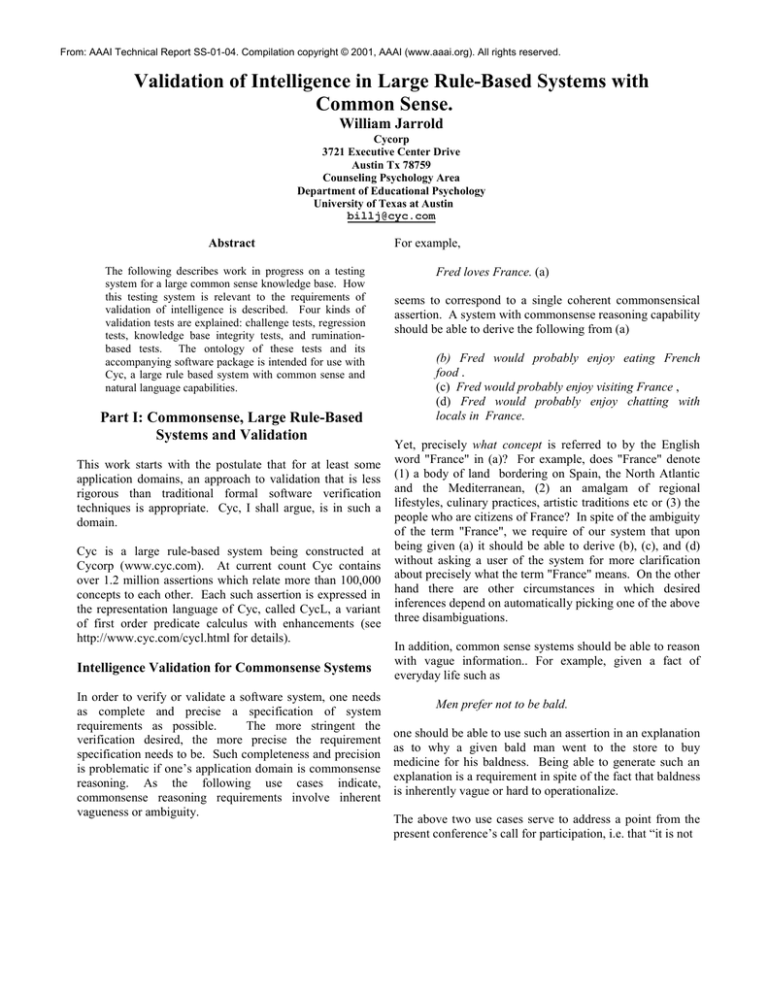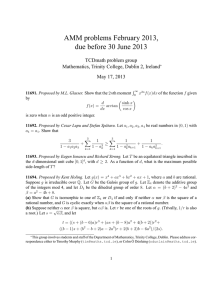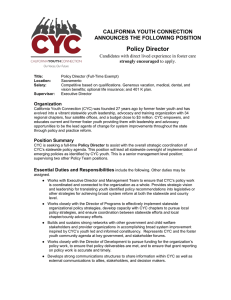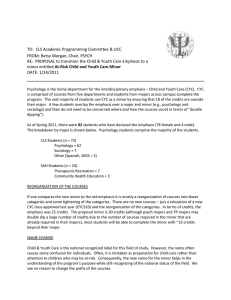
From: AAAI Technical Report SS-01-04. Compilation copyright © 2001, AAAI (www.aaai.org). All rights reserved.
Validation of Intelligence in Large Rule-Based Systems with
Common Sense.
William Jarrold
Cycorp
3721 Executive Center Drive
Austin Tx 78759
Counseling Psychology Area
Department of Educational Psychology
University of Texas at Austin
billj@cyc.com
Abstract
The following describes work in progress on a testing
system for a large common sense knowledge base. How
this testing system is relevant to the requirements of
validation of intelligence is described. Four kinds of
validation tests are explained: challenge tests, regression
tests, knowledge base integrity tests, and ruminationbased tests. The ontology of these tests and its
accompanying software package is intended for use with
Cyc, a large rule based system with common sense and
natural language capabilities.
Part I: Commonsense, Large Rule-Based
Systems and Validation
This work starts with the postulate that for at least some
application domains, an approach to validation that is less
rigorous than traditional formal software verification
techniques is appropriate. Cyc, I shall argue, is in such a
domain.
Cyc is a large rule-based system being constructed at
Cycorp (www.cyc.com). At current count Cyc contains
over 1.2 million assertions which relate more than 100,000
concepts to each other. Each such assertion is expressed in
the representation language of Cyc, called CycL, a variant
of first order predicate calculus with enhancements (see
http://www.cyc.com/cycl.html for details).
Intelligence Validation for Commonsense Systems
In order to verify or validate a software system, one needs
as complete and precise a specification of system
requirements as possible.
The more stringent the
verification desired, the more precise the requirement
specification needs to be. Such completeness and precision
is problematic if one’s application domain is commonsense
reasoning. As the following use cases indicate,
commonsense reasoning requirements involve inherent
vagueness or ambiguity.
For example,
Fred loves France. (a)
seems to correspond to a single coherent commonsensical
assertion. A system with commonsense reasoning capability
should be able to derive the following from (a)
(b) Fred would probably enjoy eating French
food .
(c) Fred would probably enjoy visiting France ,
(d) Fred would probably enjoy chatting with
locals in France.
Yet, precisely what concept is referred to by the English
word "France" in (a)? For example, does "France" denote
(1) a body of land bordering on Spain, the North Atlantic
and the Mediterranean, (2) an amalgam of regional
lifestyles, culinary practices, artistic traditions etc or (3) the
people who are citizens of France? In spite of the ambiguity
of the term "France", we require of our system that upon
being given (a) it should be able to derive (b), (c), and (d)
without asking a user of the system for more clarification
about precisely what the term "France" means. On the other
hand there are other circumstances in which desired
inferences depend on automatically picking one of the above
three disambiguations.
In addition, common sense systems should be able to reason
with vague information.. For example, given a fact of
everyday life such as
Men prefer not to be bald.
one should be able to use such an assertion in an explanation
as to why a given bald man went to the store to buy
medicine for his baldness. Being able to generate such an
explanation is a requirement in spite of the fact that baldness
is inherently vague or hard to operationalize.
The above two use cases serve to address a point from the
present conference’s call for participation, i.e. that “it is not
even clear that we know how to specify validation criteria.”
I claim that for intelligent systems with common sense, we
must settle for a less formal, less precise specification of
requirements. As the prior use cases indicate, ambiguity
and vagueness are necessary parts of requirement
specifications for a commonsense reasoners.
If
requirements must contain ambiguity and vagueness then a
formal requirement specification is impossible, making
formal verification impossible. Given these limitations,
one could argue that “validation of intelligence” should be
based on a statistical inference made based on system
performance on a sample of behaviors. In brief, I suggest
that “validation of intelligence” for commonsense systems
should be more like giving a psychological test than doing a
proof of correctness.
techniques.
To sum up, I claim that for commonsense systems,
validation of intelligence should not be a binary either/or
decision. The ambiguity and vagueness inherent in
specification of commonsense reasoning requirements
forces us to follow a validation procedure based on
performance across a possibly randomly sampled set of use
cases. Secondly, even if that claim is incorrect in some way
and advanced formal validation techniques could somehow
be tractably applied to a large Cyc-like system (e.g. based
on some fruitful hybrid of model based reasoning and model
checking) it seems to make the most sense to only apply
such relatively expensive techniques towards the end of a
project when system change rate is lower or when hard to
detect bugs are being sought out.
Common Sense and Mission Critical Systems
There are a variety of mission critical applications in
which commonsense reasoning capabilities are important.
For example, a geopolitical crisis management system
should be able to understand and reproduce human
commonsensical reasoning patterns.
An evacuation
management system should possess the emotional
intelligence required to help people remain calm in high
pressure situations. A natural language interface for an
avionics application should understand the pilot’s
colloquialisms. In general, the performance of any
mission critical system which must interface with humans
is likely to benefit greatly from commonsense capabilities.
Validation Issues and Large Scale Projects
Specification difficulties aside, another set of concerns
derives from the sheer massive scale of the effort involved.
Cyc is a project involving person-centuries of effort (Guha,
Lenat 1990). There are currently about 80 full-time
employees working for Cycorp, at least half of which send
KB edit operations (KB edit operations are atomic KB
editing events such as adding an assertion, removing an
assertion, creating a term, giving an assertion a timestamp)
to the main Cyc KB as part of their daily work. Recently
the mean rate of sending operations to the main KB was
calculated at 1900 per day (including weekends) over a 5
month period. Given the sheer volume of the effort,
multiple inconsistencies are bound creep in.
In addition, from an efficiency standpoint it makes sense to
use relatively incomplete but cheap to implement methods
to find the easiest most glaring bugs early in a project’s
lifetime. Assuming sufficient “progress happens”, i.e. Cyc
nears completion and the formal model checking/model
based validation techniques can be tractably applied to
undecidable Cyc-like systems, then it becomes appropriate
to proceed with such “big hammer” software verification
.
Part II: Specifics of the Cyc Testing System
and Techniques Validating the Intelligence of
Cyc
This section describes a working system that can validate (or
assess) Cyc’s intelligence. For reasons described above, the
system performs validation of Cyc’s intelligence as a graded
measure based on tests derived from use case type
requirements.
System validity is established by measuring different aspects
of Cyc's performance on a set of tests. The hope is that by
beginning to measure this performance across many
different dimensions with more and more tests, strides will
be made in the direction of more comprehensively validated
commonsense reasoners.
The Cyc Testing System has two main parts: a software part
and a knowledge base (KB) part. The KB part contains a
large number of test objects which make declarative
assertions about system requirements. Each test object
describes a desired system behavior in CycL. The software
part operates on a given KB test object in the appropriate
manner.
For example, depending on the assertions
associated with a particular test object, the Cyc testing
system may make calls to the inference engine or to one of
several natural language parsing systems. It may compare
current to prior results along any of several performance
dimensions such as number nodes traversed, time elapsed,
or results obtained. More details of the kinds of properties
one may associate with KB test objects are described under
the next subheading.
The Cyc Testing System can be invoked by a system user in
a wide variety of ways. It is also automatically invoked in
nightly testing runs. Results of particular tests and
summaries of test suites can be automatically emailed to
interested parties.
Test Ontology
Typically tests are represented as a reified first class
objects in the knowledge base (exception: ruminationbased tests, described below, do not yet have any explicit
knowledge base objects associated with them). The testing
ontology for the kinds of tests described below allows one
to associate numerous types of properties with a given test.
For example, one may wish to describe which knowledge
engineers are responsible for which tests, what kind of
inference parameters should be involved with a given test
(such as depth of backchaining, time, the context or
"microtheory" which should be visible to the inference
engine when a given test is run) past performance of a
given test, and more. One declaratively asserts this kind of
information to the knowledge base (KB) in a manner very
similar to the way one ontologizes “normal” common
sense or expert knowledge. For example, one may use
standard knowledge engineer interface tools, and
eventually, free-form natural language.
Additional of the Cyc Test ontology shall be described
under headings which outline four kinds of test which are
important to validating Cyc.
Regression Tests
Regression tests derive their name from software
engineering. One might have a set of inferences or natural
language parses that one has worked on for various demos,
contracts, etc. One uses a regression test if one wishes to
make sure that such inferences or parses continue to work
correctly (and within optionally specified resource
bounds).
Thus, unlike Challenge Tests (see below) a
Regression Test is, by definition, known to have worked
correctly at some time in the past. Thus, if a given
Regression Test fails, it most likely means that a KB
editing operation or inference engine code patch was done
which caused that test to fail. We typically desire to run
such tests frequently so as to be quickly informed of any
breakage and to minimize the candidate set of
KB/inference engine changes which could have caused the
breakage.
The CycL name for one such test that has been in the
system since October of last year is CST-Pratt6aRunMt. The
assertion
(isa CST-Pratt6aRunMt NightlyKBAskRegressionTest)
means that this test is one which is run once per night
automatically in virtue of certain properties of
NightlyKBAskRegressionTest omitted from this paper. Since
this test, and 120 others like it is of the “nightly KB Ask”
sort as opposed to, for example, the “nightly natural
language parsing” sort.
it checks a particular call to the Cyc inference engine, rather
than, e.g. a call to one of Cyc’s natural language parsers.
An English representation of what CST-Pratt6aRunMt iis
supposed to test can be gleaned from the following
assertion:
(testQuestionEnglish CST-Pratt6aRunMt “Can human adults run?”).
Together, the following two assertions
(testQuestionCycL CST-Pratt6aRunMt
(typeBehaviorCapable HumanAdult Running doneBy))
(testAnswersCycL CST-Pratt6aRunMt (((T T))))
mean that when the inference engine is set to work on the
query (typeBehaviorCapable HumanAdult Running doneBy) it is
expected to return “true”. (More precisely, we expect “true”
as an answer to the CycL query only when a set of inference
engine parameters are appropriately set. The parameters can
either be explicitly asserted or inherited from other parts of
the testing ontology. A detailed listing of what these
parameters are would be beyond the scope of this paper.)
Rending those two assertions in English, one could say that
the English target answer to the question “Can human adults
run?” is “yes.”
Test objects which are of type NightlyKBAskRegressionTest
should, by definition, be run automatically once per night.
Such automatic testing has been happening since late Spring
2000. An added feature of the testing system is that the
knowledge engineers can be automatically informed via
email if any tests for which they are responsible have
broken. The Cyc testing system can utilize KB information
such as
(testCyclistsResponsible CST-Pratt6aRunMt RichardM)
and
(eMailAddressText RichardM "richardm@cyc.com")
in order to send email to the correct places.
If a given test stops behaving as desired, on a run of the
regression tests, for example, a facility called the Breakage
Pinpointer can determine which recent KB edit operation, if
any, caused the test to stop working. The breakage
pinpointer does this simply by looping through the
following procedure:
(0) Start up a new Cyc image at the beginning
of yesterday’s sequence of KB edit operations.
(1) Given yesterday's sequence of KB edit
operations, execute the next N of them in
order.
(2) run the test
(3) if the test works, do (1) again else
return the information that the breakage
occurred between the operation just run
and the Nth -1, inclusive.
By setting N to 1 (for brief tests) or using larger N (for
time consuming ones) coupled with a binary search
technique one can automatically narrow down on the exact
operation which caused the breakage.
In sum, use of regression tests can facilitate validation of
intelligence by quantifying, giving timely notice of, and
locating newly added system defects.
Challenge Tests
Roughly speaking, a challenge test is analogous to a "quiz"
given to human students. In contrast with Regression
Tests, an arbitrary Challenge Test is not necessarily
expected to work successfully. Rather, the purpose of
Challenge Tests are to characterize Cyc's abilities or to
focus and stimulate work on enhancing Cyc's abilities.
This kind of test is relevant to system validators would be
interested in issues such as:
All else being equal, a more flexible KB can be more
quickly modified to meet a new set of challenges. Likewise,
a more flexible knowledge base axiomatization should
generalize to unseen "test set" cases.
Lastly, more
knowledge re-use should be attainable from a flexible
knowledge base. For these reasons, performance data on
challenge tests may be said to measure the flexibility of a
knowledge base. Since common sense systems should
accommodate new knowledge and new problems efficiently,
flexibility is arguably an aspect of the definition of validity.
KB Integrity Tests
The third kind of test is termed a kb integrity test. With
such tests, one declaratively describes structural properties
of the knowledge base which one wishes to monitor. The
purpose of such tests is not so much to state desirable enduser functionality. Rather, such tests are akin to measures of
good "KB housekeeping". A KB with high integrity is
easier to maintain and augment.
One very fundamental KB integrity test checks the syntactic
well-formedness of a given KB assertion. Another higher
level KB integrity test looks for the appropriate relationship
between argument types of predicates which are in a
subsumption relationship. For example,
(implies (brothers ?X ?Y)(siblings ?X ?Y))
Is Cyc able to answer question X?
Is the Cyc recursive block parser able to
correctly parse the phrase P?
What percentage of the instantiations of question
type Y is Cyc able to correctly answer?
Suppose that a week's worth of a given
knowledge engineer's activity was focused on
implementing a general solution to the
question battery Z (a "teach set"). How much
did Cyc's performance on that battery
improve? How well did that week's worth of
knowledge engineering generalize to the "test
set" battery Z' (of which the knowledge
engineer was unaware)? Further, suppose
that later a different knowledge engineer, was
set to work on the challenge question battery
W. How much of the early knowledge was
able to be used in the later ontologization
effort associated with W?
In Cyc the testing ontology distinguishes between
questions nstances and parameterized questions -- whole
classes of tests which vary along some specified set of
parameters. See (Cohen, Chaudri, Pease, and Schrag
1999) for more on this topic.
In English this could be described as
If two people are brothers, then they are siblings.
Thus the predicate brothers is subsumed by siblings. The
argument type for brothers is MalePerson. The argument type
for siblings is Person. The integrity constraint to be checked
by this test is that the argument type of a subsumed
predicate, e.g. brothers should be no more general than the
argument type for the subsuming predicate, e.g. siblings. If
MalePerson is asserted to be a specific kind of Person, then
this integrity constraint is not violated.
The Quality Control Group at Cycorp is responsible for
preventing too many integrity violations from cropping up.
Email messages are automatically sent to the members of
this group by the same nightly testing mechanism that the
above mentioned nightly kb ask regression tests use.
Rumination-Based Tests
The goal of rumination-based testing is to allow discovery
of particular deductions that Cyc can make that were
otherwise unanticipated. Discoveries can be welcome
surprises about assertions comingling in unanticipated but
desireable ways or undesirable interactions between
incompatible assertions. An overall quality measure of such
deductions suggests how well knowledge base content
synergizes.
(2) Add an exception to (G1) such that it reads
(G1) Spouses love each other except in cases of infidelity.
The following anecdote of an exploratory foray into
rumination-based testing methods shows how the
technique works. The Cyc system was set to backchain on
the following cycl query:
(feelsTowardsEvent ?agent ?emotion ?event-or-object ?level).
("Does anyone feel any emotion to any degree about any
event or any object.")
Results of the query were cached and the procedure was
repeated several times. There were hundreds of
conclusions, the vast majority of them were correct, even
surprising in some cases. For example, Cyc inferred that
Queen Elizabeth II feels loyalty towards England, that
various Cycorp employees loved their spouses and their
children, and that Abraham Lincoln felt fear at the time of
his assassination. In a microtheory devoted to the beliefs of
Christianity the system even inferred that God loves his
son Jesus Christ.
But, what was most amusing and not very intelligent
seeming was the following deduction.
(D) (feelsTowardsEvent HillaryClinton Dislike BillClinton None)
Hillary Clinton feels zero dislike towards Bill Clinton.
Translating these axioms into psuedo English the givens
responsible for the above deduction can be stated as
follows:
(G1) Spouses love each other.
(G2) Love and dislike are contrary emotions.
(G3) If ?PERSON1 feels emotion ?E1 towards
?PERSON2 and ?E2 is contrary to it, then the level at
which ?E2 is felt is zero.
(G4) Bill Clinton is Hillary Clinton's spouse.
Each one of the above givens may appear roughly correct
standing on its own. However, when chained together they
led to the conclusion (D) which most people would rank as
false.
There are several possible repairs for such a deduction:
(1) Split apart the concept Love into at least two forms,
one would denote a brief "in the moment" feeling
inconsistent with dislike. The second would denote a
long term affective disposition frequently felt by
spouses which is not necessarily
Then add a representation of the Monica Lewinsky affair to
the Cyc KB.
In this way, a kind of introspection test or open-ended
querying may be used to evaluate the overall synergy of a
KB, locate problematic assertions or terms, and, thereby
obviate particular improvements. A crude measure of this
synergy or reliability could be simply by taking the ratio of
deductions judged invalid vs. valid by some human judges
based on their intuitions about what seems commonsensical.
Having introduced the general nature of rumination-based
testing, a more complete rendering of this technique follows.
First, one specificies a rather open ended inferencing task or
series of tasks for the system to perform within (user
specified) bounds of specified computational resources
constraints (e.g. time limit, maximum deduction chain
length, contexts in which to perform the deduction etc).
Exactly what sorts of tasks may be performed are described
below. Because rumination-based tests may take several
hours on current standard desktop PC machines at Cycorp
they are best done at night.
Secondly, once such a task is completed, knowledge
engineers perform a quality control analysis on the resulting
deductions. Human evaluators look at the results of such a
procedure and rate deductions along quality dimensions
such as "Was the deduction common-sensical." or "Did the
deduction seem an interesting demonstration of Cyc's
capabilities or was it merely a banal obvious fact." In
certain cases there are so many deductions made, that the
best one can do is randomly sample the set of deductions
and make statistical generalizations about the entire set.
There are several techniques for generating a sampling the
resource bounded deductive closure of a given aspect of the
KB. The simplest method involves forward chaining all
rules in a given context or set of assertions. Another method
involves simply backchaining on the consequent of every
rule in the given assertion set. A third method involves
repeatedly picking one rule at random, instantiating its
antecedent, picking another rule and backchaining on its
consequent. A fourth method, called "Open Ended Asks",
involves repeatedly picking an arbitrary n-ary predicate,
P(X1,X2, ...Xn) and asking the inference engine for all
bindings of X1, X2, ...Xn .
On a recent run, this latter technique, i.e. open ended asks,
were performed on 634 arbitrarily chosen predicates. 6229
deductions were made over an 8 and a half hour test run.
My informal quality control analysis suggested that the
frequency of non-commonsensical to commonsensical
deductions was between 1 in 10 and 1 in 1000.
In addition, the results were spot checked for interesting
non-commonsensical deductions which could be easily
described in this article. One such deduction which caught
my eye showed up in natural language browsing mode
exactly as follows:
"Vienna is wet."
Rendered in CycL viewing mode the assertion appears as
follows:
(wetnessOfObject CityOfViennaAustria Wet)
The deduction, shown exactly as it appears in the interface
is shown below:
Argument : Deduction #395917
(implies
(and
(touches ?U ?X)
(isa ?U ?TYPE)
(genls ?TYPE LiquidTangibleThing))
(wetnessOfObject ?X Wet)) in BaseKB
(touches DanubeRiver CityOfViennaAustria) in
WorldGeographyDualistMt
:ISA (isa DanubeRiver LiquidTangibleThing) in InferencePSC
:GENLS (genls LiquidTangibleThing LiquidTangibleThing) in
InferencePSC
In colloquial english the above can be rendered as follows:
Vienna is wet because:
(1) The Danube River touches the City of Vienna.
(2) The Danube River is a Liquid.
(3) If a liquid touches an object, then that object is wet.
After identifying this infelicitous combination of
assertions, it was decided to create a new attribute called
PartiallyWet whose meaning was that at least some part of
the object was wet but not necessarily the entire object.
(3) was then re-written as:
(3) If a liquid touches an object, then that object is at
least partially wet.
More rigorous measurements using this technique are in
order.
Conclusion
Although commonsense reasoning capability is arguably a
desirable property of mission critical systems, difficulties
associated with the specification of commonsense
reasoning requirements suggest that the validation of the
"intelligence" of such systems should be done in a way
which differs from traditional software systems. Because of
such limitations, rather than creating a precise, general and
complete specification, the best one can hope for is that
validation criteria be delineated by performance across a
comprehensive set of salient use cases. Intelligence validity
dimensions of regression, flexibility, internal consistency
and synergy were sketched. With further deployment of the
ontology based testing system and thorough analysis of
results obtained, there is hope for validity measures that go
beyond the impressionist formulations outlined above.
Acknowledgements
Thanks to Jim Zaiss for many helpful suggestions.
Bibiography
Cohen, Chaudhri, Pease and Schrag (1999), Does Prior
Knowledge Facilitate the Development of Knowledge Based
Systems, proceedings of AAAI-99.
Cohen, Schrag, Jones, Pease, Lin, Starr, Gunning, and Burke
(1998), The DARPA High Performance Knowledge Bases
Project, AI Magazine, Vol. 19 No.4, Winter.
Guha, R. V. and D. B. Lenat. (1990) "Cyc: A Midterm
Report." AI Magazine, Fall .





